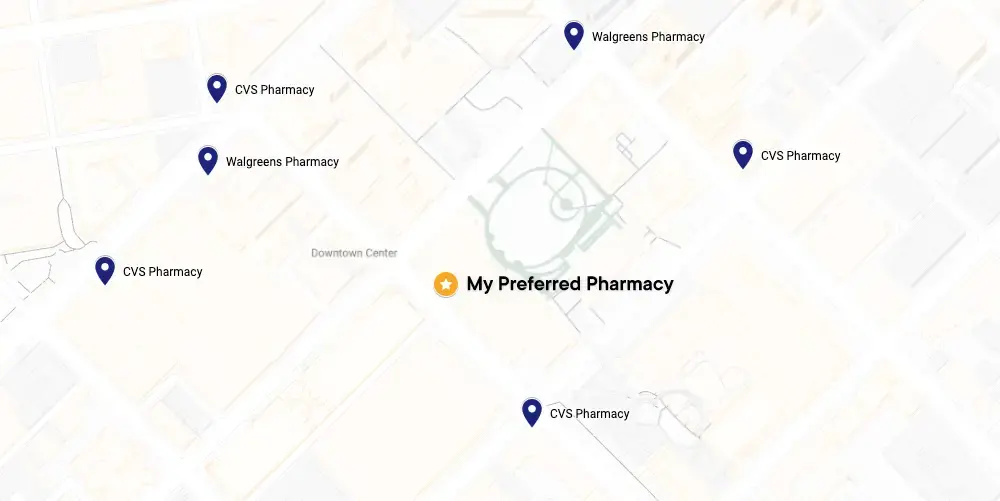
Prescription antihistamine available online
Learn how prescription antihistamines can help with allergy symptoms and more with a consultation from one of our board-certified primary care doctors online. Get a new prescription for antihistamines or refill an existing prescription today.*
About prescription antihistamines
Antihistamines are medications designed to treat allergy symptoms. They’re often prescribed to help treat histamine-mediated conditions, but they’re also used for other conditions. There are two types of prescription antihistamines.
What antihistamines treat
The most common condition treated with antihistamines are allergies and allergic reactions. The drugs are designed to bind to, and therfore block, H-1 receptors (histamine-1), which play a crucial role in allergic reactions. These prescriptions or over-the-counter products are effective treatment options for a wide range of allergies, from seasonal to insect stings or bites, conjunctivitis, hives, and hay fever.
Over-the-counter antihistamines can alleviate symptoms like:
-
Runny nose
-
Nasal congestion
-
Itchiness
-
Nasal swelling
-
Skin rashes
-
Watery and itchy eyes
-
Sneezing
-
Hives
Antihistamines can significantly improve these symptoms, helping patients feel better during the day and get enough shut-eye at night. These medicines that can alleviate allergy symptoms include capsules, pills, and liquids, including eye drops, nasal sprays, and chewable tablets. In medical settings, a healthcare professional can use injectable antihistamines forms. Injectables are often used when there is a severe life-threatening allergic reaction.
Other conditions are also treated with antihistamines, including insomnia and motion sickness. Taking antihistamines can prompt drowsiness by operating against histamine. In some circumstances, these medicines can mitigate sleeplessness when traveling.
Types of antihistamines available online
The 2 types of antihistamine medications are called:
-Non-drowsy antihistamine – Also called second-generation antihistamines, medicines like loratadine, acrivastine, fexofenadine, and cetirizine, have fewer odds of making people sleepy.
-Drowsy antihistamine – First generation antihistamines like cinnarizine, promethazine, diphenhydramine, chlorphenamine (Piriton), and hydroxyzine can make people sleepy.
You can get antihistamines with or without a prescription. OTC products include Allegra, Benadryl, Claritin, Chlor-Trimeton, Tavist, and others. Some are prescription-only medicines with higher concentrations of active ingredients than their OTC counterparts. These can consist of Clarinex, Palgic, Phenergan, and others.
There is no specific antihistamine type that works best for everyone. Some people find specific types to work better for them. The non-drowsy variants seem a popular option when carrying out daily activities. But, if the allergy symptoms stop you from sleeping, then the drowsy medicine can be a more suitable alternative.
H-1 receptor antagonists (blockers)
First-generation antihistamines can manage your sleep-wake cycle, all thanks to their sedative compounds. Sedating antihistamines have an easier time crossing the blood-brain barrier, while second-generation antihistamines don’t.
Second-generation antihistamines lack such sedative compounds. Classic examples of second-generation products include Loratadine (Claritin) and Fexofenadine (Allegra).
Some allergy medications work differently in the system and could be safely used together. For example, if you take an oral antihistamine like cetirizine, you can also use ketotifen or antihistamine eye drops to treat symptoms of watery eyes or itchy eyes.
Nasal sprays, decongestants, and steroids could be taken alongside oral antihistamines. They can work differently to relieve symptoms like congestion or runny nose. But, it is crucial to talk to a healthcare provider before using any medications together to alleviate the
H-2 receptor antagonists (blockers)
Antihistamines that bind to H-2 receptors are often used to treat upper gastrointestinal problems. These problems are triggered by too much stomach acid. H-2 antihistamines can treat the symptoms of:
When you choose which medication to take, please consult a specialist. For minor health problems, you can go for OTC products. See if the product you are interested in matches the symptoms you want to treat. Prescription-only antihistamines are stronger than OTC products and are better at alleviating severe allergies.
How antihistamines work
Antihistamines function by blocking or reducing histamine. Thus, stopping the symptoms of an allergy. When the body comes in contact with an allergy trigger, it stimulates the production of a substance called histamine. That trigger can be anything, from dust mites and pollen to pet dander and ragweed.
The tissue in the nose begins to swell, which ends up causing a running or blocked nose. And watery eyes. At other times, people get hives or other skin rashes, which cause itchy skin. Antihistamines are here to stop the reaction to indoor, food, and seasonal allergies.
A healthcare provider might suggest using a decongestant with an antihistamine for a blocked nose. Nasal sprays work to ease the sneezing, runny, or itchy nose, including a postnasal drip. The doctor can suggest eye drops if you are dealing with eye allergies. These drops work to ease the swollen, red, and itchy eyes.
You need to know how to store the allergy meds to make sure they work. Each medication has unique storage requirements, such as keeping them at room temperature or in the fridge. Check the exact storage instructions on the product you are using. You'll need to store the medicine in a dry area, preferably the bedroom. Avoid putting them in the kitchen or bathroom. Moisture and heat can damage the medicine.
Keep the product away from the reach of pets and children. If you notice the antihistamines have expired, throw them away. Don’t use the medicine beyond its expiration date. Keep the original packaging or container of the product. These are designed to provide the medication with optimal storage. If you plan to travel, carry the medicine into the cabin. The cabin maintains stable moisture and temperature levels, which can work well for your medication.
Most syrups and liquids require storage of about 15°C to 30°C. This means you wouldn’t be storing it in the fridge. Check the packaging on the bottle to find optimal storage. Keep the product closed when not in use to prevent a contamination risk with eye drops. Store it away from direct sunlight. Light and heat can also damage sprays.
Side effects of antihistamines
When taken as prescribed, antihistamines are generally well tolerated. However, they can still cause some side effects.
The most common side effect of antihistamines is drowsiness. Other less common side effects include:
In rare cases, antihistamines may cause serious side effects. These can include:
According to peer-reviewed studies, H-1 antihistamines typically cause more noticeable side effects. These side effects are more common with first-generation antihistamines, whereas second-generation antihistamines have limited side effects.
H-2 receptors tend to be well-tolerated. But, they can still cause side effects. Gastrointestinal changes, confusion, dizziness, and fatigue can occur.
Antihistamine risks
Antihistamines are generally safe, but there are some risks if you have other medical conditions or take certain medications.
Before you take a prescribed antihistamine, be sure to tell your doctor if you have any of the following health conditions or issues:
To minimize the risk of side effects or other health problems, take only the recommended amount, specified on the label. If you take more, it won’t work faster or better. Instead, it can be dangerous for your health. If you have an Allegra allergy or Zyrtec allergy, talk to a doctor to get other medicines that can accommodate your needs.
Antihistamine drug interactions
When you begin a new medication, make sure to tell your doctor about any other medications, supplements, or herbs you’re taking. Some medications that might interact with an antihistamine include:
-
Other antihistamines (i.e., ointment, diphenhydramine cream, and spray)
-
Blood pressure medication (such as beta blockers and calcium channel blockers)
-
MAO inhibitors
-
Seizure meds
-
Narcotic pain medicine
-
Muscle relaxants
Talk to a pharmacist or doctor if you use other products that can lead to drowsiness, like cough relievers, pain meds, and drugs for anxiety and sleep. Using cannabis and alcohol can also make you drowsy, so avoiding products that can lead to a drop in blood pressure and drowsiness is essential.
If you plan on using products like these, consult an expert about using them safely. Antihistamines could interfere with some lab/medical tests, such as urine drug testing and brain scans for Parkinson’s disease. Therefore, it would be best to notify the lab personnel if you are using antihistamines.
Antihistamines you can get online
Antihistamines FAQs
How should I take antihistamines?
Who shouldn’t take antihistamines?
When your doctor suggests you use antihistamines, be sure to let them know of any other medicines you might be using, including other health conditions, you might have such as high blood pressure, thyroid, heart disease, glaucoma, or BPH.
How long does it take for antihistamines to work?
What should I avoid with antihistamines?
When treating an allergy with a product like this, avoid drinking alcohol. Alcohol can increase the odds of drowsiness and make you sleepy. Other consumables, foods, and drinks don’t affect most antihistamines. However, be sure to check the leaflet for other things you should avoid.
What do antihistamines do to your body?
Which drugs are antihistamines?
What is antihistamine used for?
3 simple steps to getting antihistamines online

Book an appointment to discuss antihistamines.

Talk to your doctor online.

Pick up your antihistamine prescription from your online doctor.
Antihistamines pricing details
30 days of free membership
- Same-day appointments 7 days a week
- Unlimited messages with your Care Team
- Prescription discount card to save up to 80%
- Exclusive discounts on lab tests
- Free memberships for your family
- Cancel anytime
Paying with insurance
Membership
$19.99
First month free
Visits
Copay
Visit price with insurance
Often the same as an office visit. Most patients with in-network insurance pay $30 or less!
We accept these insurance plans and many more:



Paying without insurance
Membership
$19.99
First month free
Visits
$129
Visit price without insurance
Antihistamines resources
Sources:
PlushCare is dedicated to providing you with accurate and trustworthy health information.
-
Cleveland Clinic: "Antihistamines." Cleveland Clinic. Accessed on December 14, 2023, at https://my.clevelandclinic.org/health/drugs/21223-antihistamines.
-
MedlinePlus: "Antihistamines." MedlinePlus. Accessed on December 14, 2023, at https://medlineplus.gov/ency/patientinstructions/000549.htm.
-
Mayo Clinic: "Antihistamine (Oral Route, Parenteral Route, Rectal Route)." Mayo Clinic. Accessed on December 14, 2023, at https://www.mayoclinic.org/drugs-supplements/antihistamine-oral-route-parenteral-route-rectal-route/description/drg-20070373.
PlushCare content is reviewed by MDs, PhDs, NPs, nutritionists, and other healthcare professionals. Learn more about our editorial standards and meet the medical team. The PlushCare site or any linked materials are not intended and should not be construed as medical advice, nor is the information a substitute for professional medical expertise or treatment.